Recycled Art – Environmental Art Made from Trash
Recycled art, also known as art made from recycled materials, has emerged as a captivating and thought-provoking genre within the art world. This innovative form of artistic expression encompasses a wide range of creative endeavors, including recycled art projects, recycled sculpture art, trash sculpture, garbage art, and art made from trash. By transforming discarded materials into aesthetically appealing and conceptually rich artworks, artists in this realm challenge conventional notions of beauty, materiality, and sustainability, while highlighting the potential for reimagining and repurposing our everyday waste. In this article, we will explore all things recycled art!
Recycled Art
Recycled art, an artistic practice that repurposes discarded materials into captivating artworks, has experienced a remarkable evolution throughout history. The art historical development of recycled art showcases its enduring presence and significance within the realm of artistic expression. From the pioneering efforts of Dada and Surrealism to the radical approaches of Fluxus, recycled art has evolved into a vibrant and socially conscious movement. Its impact on contemporary art is undeniable, serving as a catalyst for reimagining materials, challenging established norms, and fostering greater awareness of our relationship. This section of the article delves into the origins of using trash in art, explores the motivations behind this unconventional approach, examines the art movements that contributed to the rise of recycled art, and investigates its profound influence on the trajectory of contemporary art.
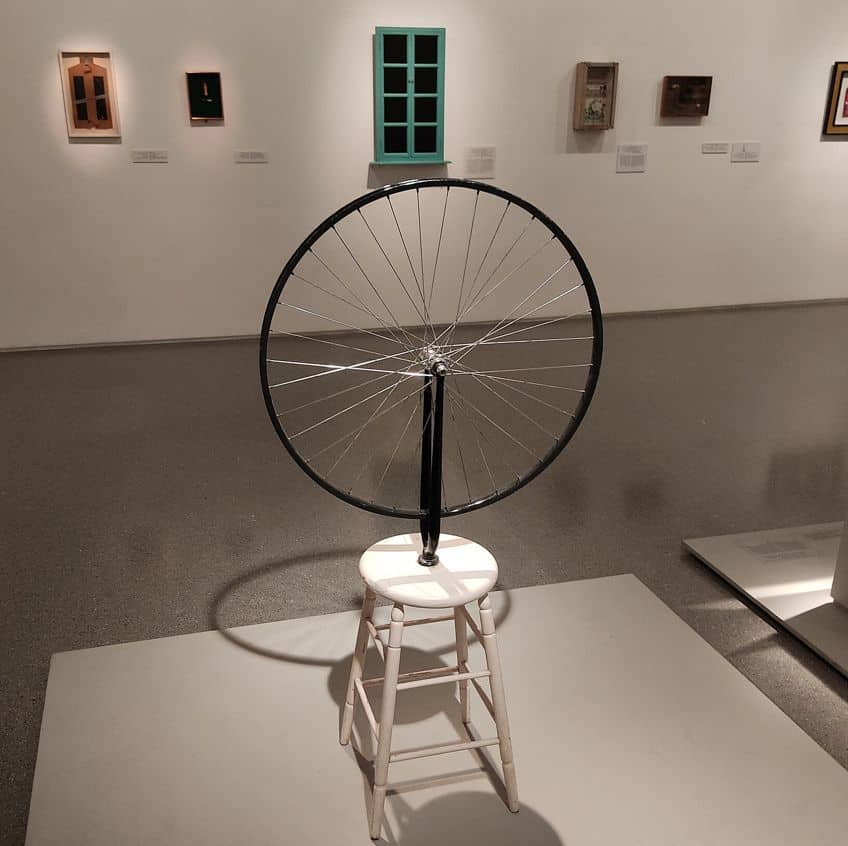
The Emergence of Art Made from Trash
The utilization of trash in artistic endeavors can be traced back to the early 20th century. In the wake of World War I, artists began incorporating found objects and discarded materials into their works. One notable pioneer was the Dada movement, which emerged in the 1910s and 1920s. Dadaists such as Marcel Duchamp (1887-1968) challenged traditional notions of art by presenting everyday objects as artworks, often with a touch of irony and absurdity.
Duchamp’s readymades, such as Fountain (1917), a urinal signed with the pseudonym “R. Mutt,” served as provocative statements and marked a significant shift in the perception of artistic materials.
Motivations Behind Trash in Art
The use of trash in art was driven by multiple factors. Artists sought to challenge the established art world hierarchy and its elitism by democratizing art materials. By incorporating discarded objects, they aimed to bridge the gap between art and everyday life, blurring the boundaries between high and low culture. Additionally, using trash as artistic material was a response to the pressing social, political, and environmental concerns of the time. It served as a visual commentary on consumerism, waste, and the disposable nature of modern society.
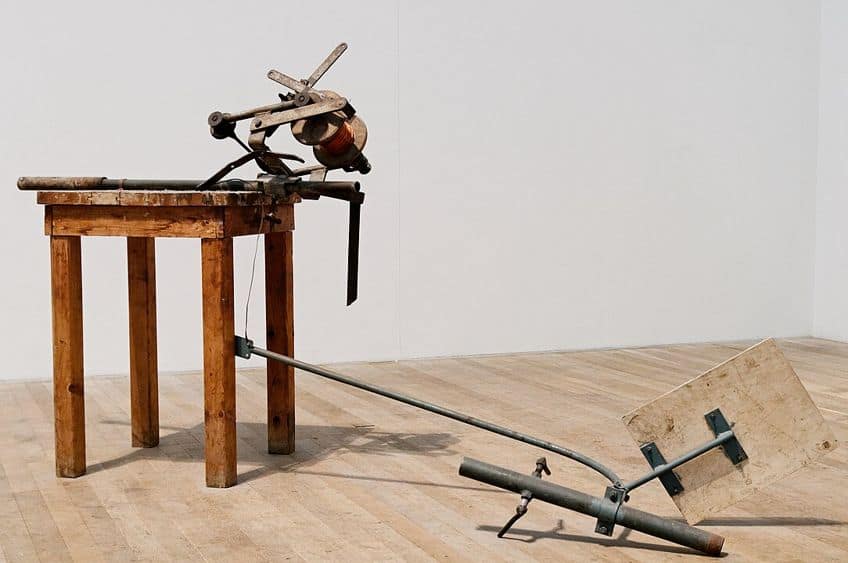
Art Movements and Recycled Art
Several art movements played a significant role in paving the way for the rise of recycled art. The Surrealists, for instance, embraced the idea of the found object as a means to tap into the unconscious mind and explore the realm of dreams. Artists like Salvador Dalí (1904-1989) and Meret Oppenheim (1913-1985) incorporated mundane objects into their artworks to evoke unexpected associations and challenge conventional reality. The Fluxus movement of the 1960s and 1970s further expanded the boundaries of recycled art. Inspired by Dada, Fluxus artists embraced a multidisciplinary approach that included performances, installations, and assemblages.
Figures such as Joseph Beuys (1921-1986) and Nam June Paik (1932-2006) incorporated discarded materials into their works, often with an emphasis on social and political commentary.
Influence on Contemporary Art
The advent of recycled art has had a profound impact on the evolution of contemporary art. It has prompted a shift in artistic practice, highlighting the importance of sustainability, environmental consciousness, and social responsibility. Artists today actively engage with recycled materials, creating thought-provoking installations, sculptures, and mixed-media artworks that address pressing global issues.
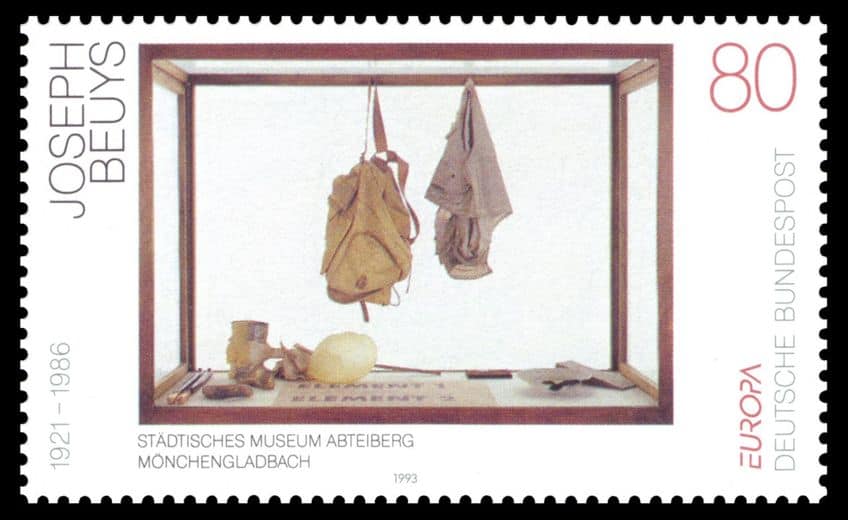
Recycled art has also sparked a reevaluation of the notion of value in art. By repurposing discarded materials, artists challenge the traditional reliance on expensive and rare art supplies. They encourage viewers to reassess the inherent worth and transformative potential of overlooked objects. Moreover, recycled art has inspired a new wave of creativity, fostering innovative approaches to materiality and technique. Artists experiment with various recycling processes, combining traditional art-making methods with contemporary technologies, resulting in visually striking and conceptually rich artworks.
Upcycled Art vs. Downcycled Art: Exploring Creative Approaches to Recycling in Artistic Expression
Recycling has become a significant aspect of our efforts to promote sustainability and reduce waste. In the realm of art, recycling takes on a unique form, with artists repurposing materials to create captivating and thought-provoking artworks. Two distinct approaches that have emerged in the world of recycled art are upcycled art and downcycled art. While both practices involve the use of discarded materials, they differ in their intentions and methods. This article delves into the concepts of upcycled art and downcycled art, examining their characteristics, creative processes, and the impact they have on artistic expression and environmental consciousness.
Upcycled art, also known as creative reuse, is an approach that focuses on transforming discarded materials into artworks of higher value or quality.
Upcycling involves repurposing materials in a way that enhances their original purpose or function. Artists who practice upcycled art often seek to highlight the beauty, uniqueness, and potential of discarded items. They employ innovative techniques, craftsmanship, and artistic vision to breathe new life into materials that would otherwise be discarded as waste. The resulting artworks not only possess aesthetic appeal but also convey a message of resourcefulness, sustainability, and the potential for transformation.
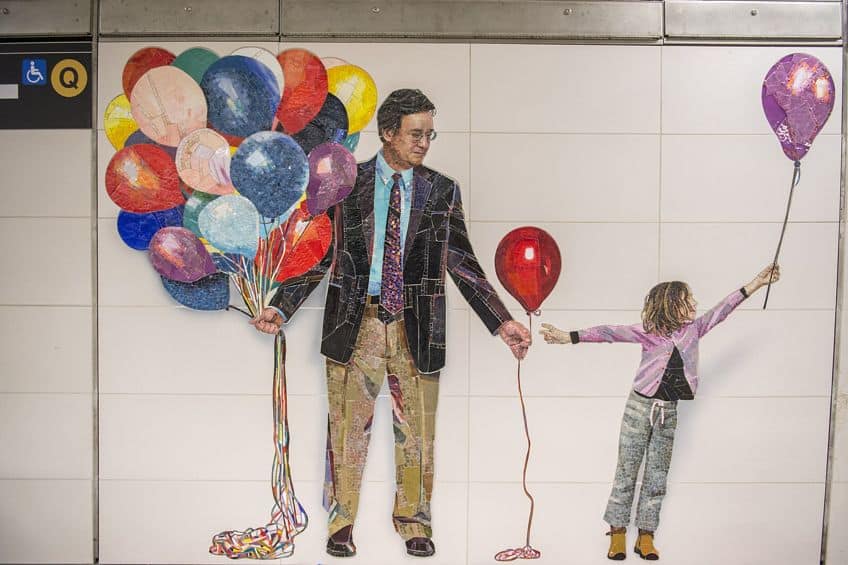
On the other hand, downcycled art, sometimes referred to as reductive recycling, takes a different approach. It involves breaking down materials and transforming them into new objects or materials of lesser value or quality. Unlike upcycling, downcycling does not prioritize the preservation of the original material’s quality or functionality. Instead, it aims to repurpose materials in a way that extends their lifespan or redirects them to a new purpose, even if it involves a reduction in value or functionality.
Downcycled art often highlights the inherent limitations and imperfections of the materials used, emphasizing the cyclical nature of consumption and waste.
Both upcycled art and downcycled art contribute to the larger conversation about sustainability and environmental awareness. Upcycled art showcases the potential for creativity and transformation in reimagining waste materials, while downcycled art draws attention to the limitations and challenges of recycling and the need for responsible consumption. Together, these approaches to recycled art challenge conventional notions of beauty, material worth, and the concept of waste itself.
Recycled Art and Environmental Awareness: Transforming Waste into Inspiration
In an era of escalating environmental concerns, recycled art has emerged as a powerful medium for promoting environmental awareness and inspiring positive change. By transforming discarded materials into compelling works of art, artists not only challenge our perception of waste but also foster a deeper understanding of our impact on the environment.
This section of the article explores the intrinsic connection between recycled art and environmental consciousness, highlighting the role of artists as catalysts for change and advocates for sustainable living.
Redefining Waste
Recycled art challenges the conventional notion of waste by showcasing its transformative potential. Instead of contributing to landfills or polluting our ecosystems, discarded materials are repurposed, upcycled, and given new life as artistic creations. Through this process, artists emphasize the importance of reevaluating our relationship with consumerism, waste production, and the finite resources of our planet.
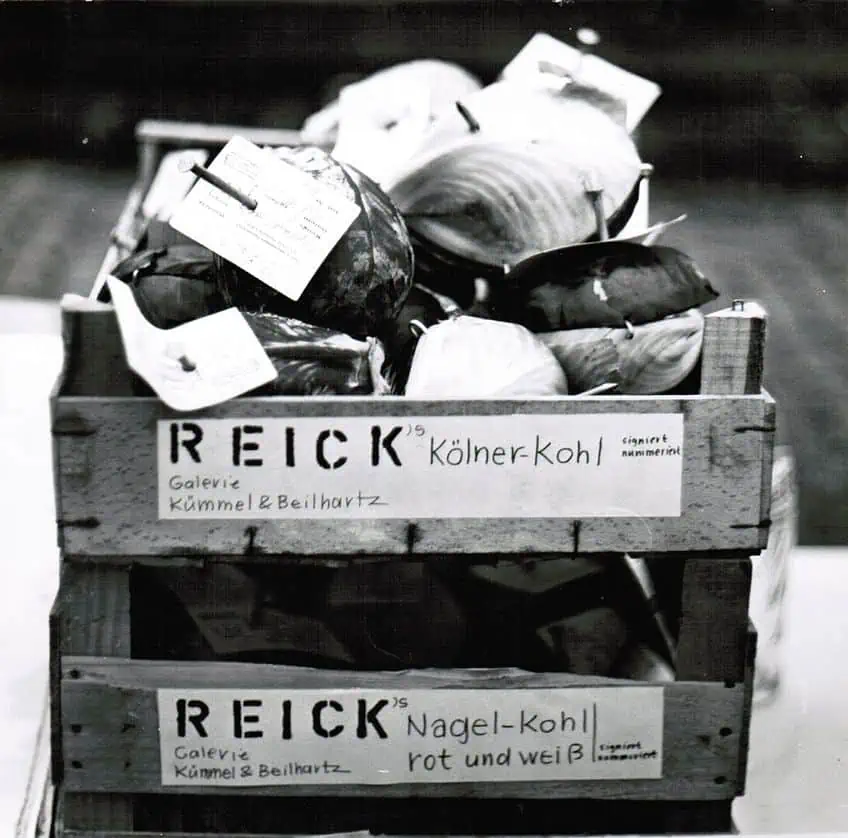
Inspiring Sustainable Practices
Recycled art serves as a source of inspiration for adopting sustainable practices in our daily lives. By demonstrating the beauty and value inherent in repurposed materials, artists encourage individuals, businesses, and communities to embrace recycling, upcycling, and responsible waste management.
The transformative power of recycled art inspires us to think creatively about waste reduction and to seek innovative solutions for a more sustainable future.
Raising Awareness
One of the primary goals of recycled art is to raise awareness about environmental issues. By presenting familiar objects and materials in unexpected ways, artists prompt viewers to reconsider their own consumption habits and the broader impact of waste on the planet. Recycled artworks often serve as visual metaphors, evoking emotions and sparking conversations about sustainability, climate change, deforestation, pollution, and the importance of preserving biodiversity.
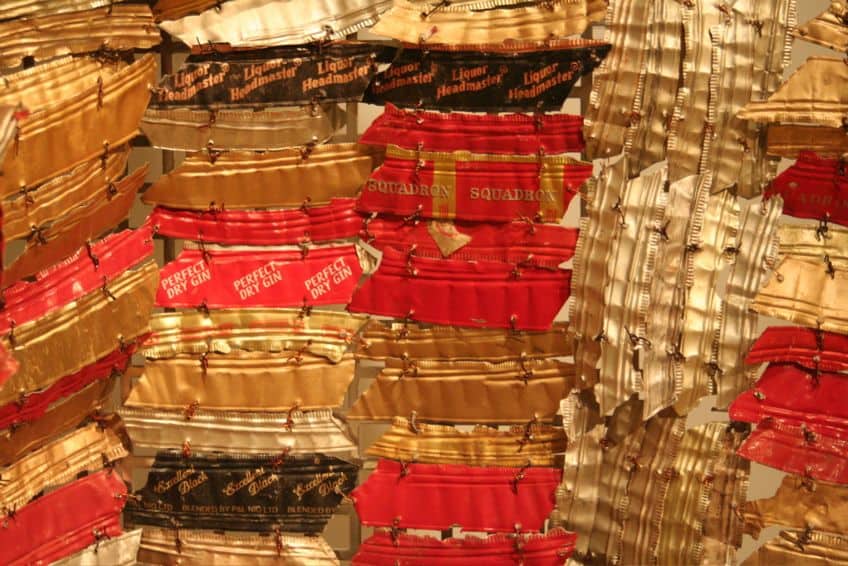
Collaborations and Community Building
Recycled art often thrives on collaboration and community engagement. Artists, environmental organizations, and local communities come together to collect, repurpose, and showcase materials that would otherwise end up in landfills. This collective effort strengthens social connections, promotes a sense of shared responsibility, and cultivates a culture of environmental stewardship.
Through community-based recycled art projects, participants gain a deeper understanding of the interconnectedness between art, sustainability, and community well-being.
Education and Engagement
Recycled art acts as an educational tool, engaging audiences of all ages in learning about environmental issues. Exhibitions, workshops, and public installations provide platforms for artists to share their creative processes, challenges, and messages about sustainability. By actively involving the community, recycled art initiatives foster a sense of environmental responsibility, empowering individuals to become agents of change in their own lives and communities.
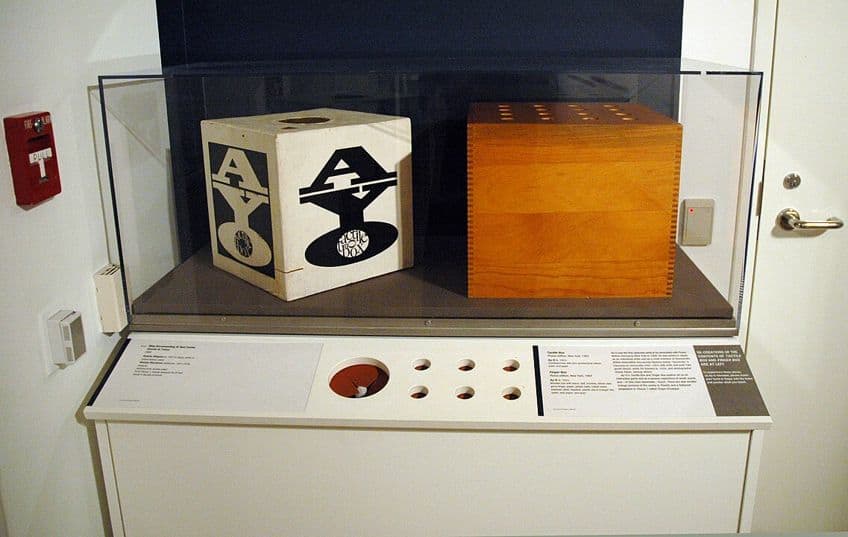
From Artistic Expression to Advocacy
Recycled art has evolved beyond mere artistic expression to become a powerful form of advocacy for environmental causes. Artists use their creative talents to address pressing environmental issues, amplify marginalized voices, and instigate change.
Their artworks serve as visual narratives, communicating the urgency of environmental conservation and inspiring viewers to take action.
Recycled Art and Relationality: Connecting People, Materials, and the Environment
Recycled art not only demonstrates a deep commitment to environmental sustainability but also embodies a profound sense of relationality. This unique form of artistic expression establishes connections between people, materials, and the environment, fostering a renewed understanding of our interconnectedness. This section of the article explores the concept of relationality in recycled art, emphasizing how artists use discarded materials to create meaningful relationships that transcend conventional boundaries and inspire a sense of collective responsibility.
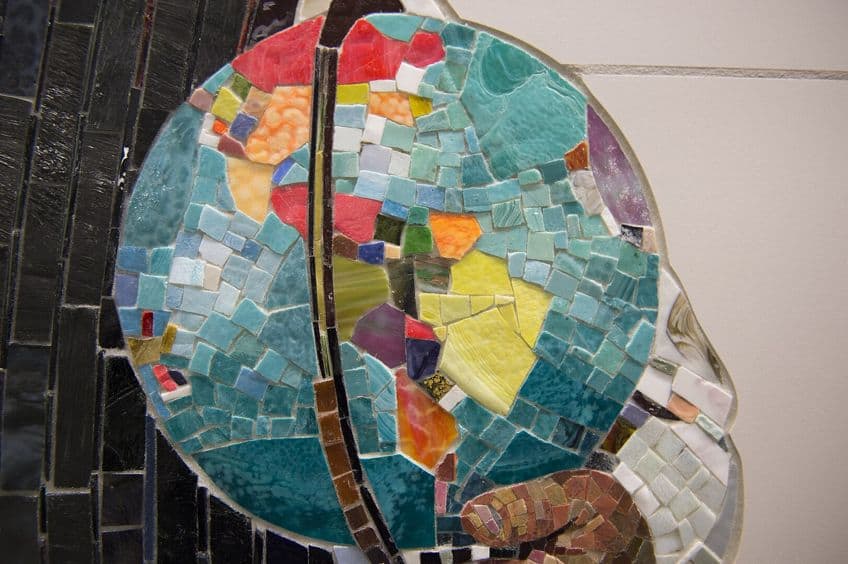
Humanizing Waste
By transforming waste into art, recycled artists humanize the discarded and overlooked. Through their creations, they evoke empathy and compassion, reminding us that everything has inherent value. Artworks made from recycled materials tell stories of resilience, resourcefulness, and adaptability, bringing attention to the often-neglected aspects of our consumerist society.
In this way, recycled art encourages us to recognize the humanity and interconnectedness of all things, including the objects we discard.
Reimagining Material Relationships
Recycled art challenges the traditional relationship between artists and materials. Instead of starting with a blank canvas or pristine materials, artists engage with discarded objects and materials, giving them new life and purpose. Through this process, they forge a connection with the materials, valuing their history, and imbuing them with new narratives. Recycled art invites us to reconsider the inherent worth of objects, promoting a deeper appreciation for their inherent beauty and potential.
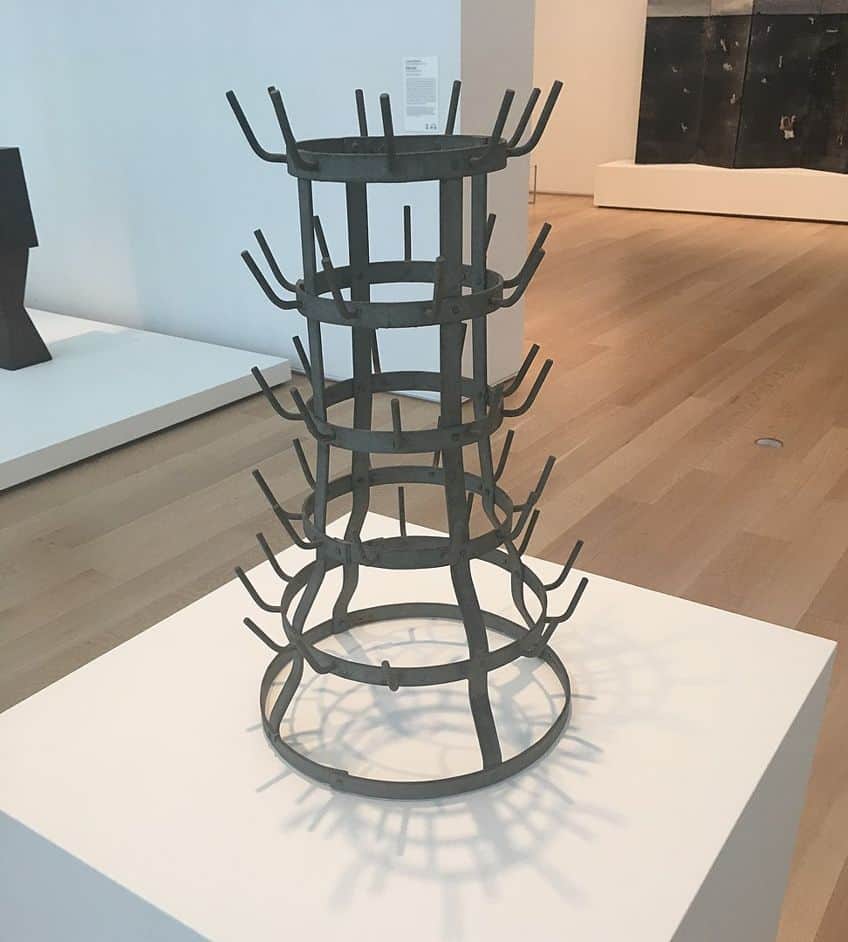
Environmental Relationality
Recycled art fosters a profound sense of relationality with the environment. By repurposing materials that would otherwise contribute to waste and pollution, artists demonstrate our direct impact on the natural world. Through their creative process, they encourage us to reconsider our relationship with the environment, highlighting the importance of conservation, sustainable practices, and mindful consumption.
Recycled art invites us to see ourselves as active participants in the ecosystem, reminding us of our responsibility to protect and nurture the planet.
Engaging Viewers
Recycled art establishes a dynamic relationship between the artist, the artwork, and the viewer. The process of creating art from discarded materials prompts viewers to question their own relationships with consumption, waste, and sustainability. By engaging with recycled artworks, viewers become active participants in the narrative, as they consider the interconnectedness of their choices and actions with the broader environmental context. Recycled art sparks dialogue and reflection, fostering a sense of collective responsibility and inspiring individuals to make conscious decisions in their own lives.

Community and Social Relationality
Recycled art often transcends the boundaries of individual artistic expression and extends into community involvement. Collaborative projects and participatory installations bring people together, fostering a shared sense of purpose and responsibility. Through community-based initiatives, recycled art creates spaces for dialogue, collaboration, and reflection on collective environmental challenges.
By working together, artists and communities strengthen their relationships with one another and with the environments they inhabit.
Art As a Catalyst for Change
Recycled art demonstrates that artistic practice can serve as a catalyst for transformative action. By creatively repurposing materials and promoting sustainable values, artists inspire viewers to reconsider their own relationships with consumption and waste. Through exhibitions, public installations, and community events, recycled art initiatives provide opportunities for education, awareness-raising, and collective action. By connecting art, environmental sustainability, and social change, recycled art becomes a powerful tool for inspiring a more sustainable and interconnected world.
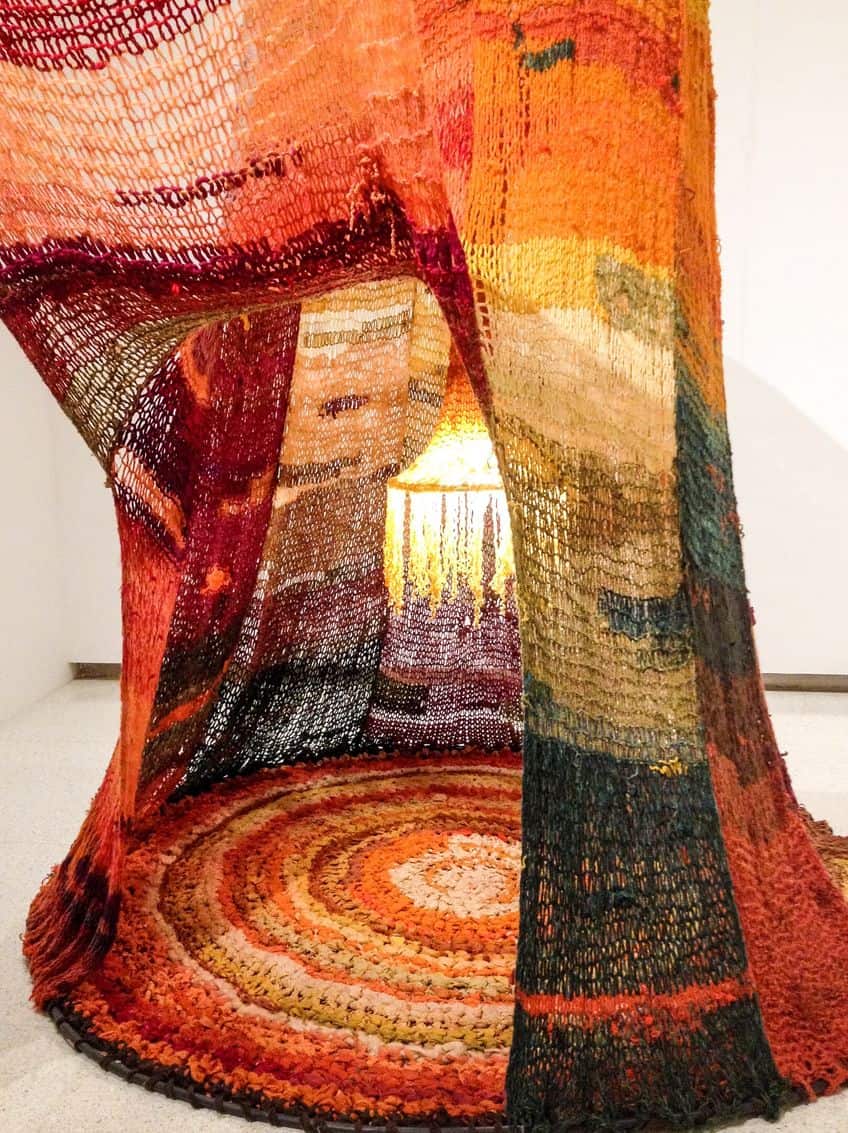
Recycled Art: Challenging and Engaging the Ideals of Beauty
Recycled art, with its unconventional use of discarded materials, pushes the boundaries of traditional aesthetics and challenges the established ideals of beauty. By repurposing and transforming waste into visually striking artworks, recycled artists provoke thought, spark conversations, and redefine our understanding of beauty.
This article explores how recycled art challenges and engages the ideals of beauty, encouraging viewers to reconsider their preconceived notions and embrace a more inclusive and sustainable vision of aesthetic appreciation.
Redefining Aesthetic Norms
Recycled art challenges the prevailing notion of beauty by redefining the materials and forms that are considered visually pleasing. By incorporating discarded objects and materials into their creations, artists disrupt the conventional standards of beauty that prioritize pristine and precious materials. Through their imaginative use of repurposed materials, recycled artists open our eyes to new possibilities and expand our understanding of what can be considered beautiful.

Transformative Beauty
Recycled art showcases the transformative power of creativity and highlights the inherent beauty in repurposing materials. Through the artist’s vision and craftsmanship, discarded objects are reborn into something entirely new, often surpassing their original intended purpose. The process of transformation imbues the artwork with a narrative and an aesthetic value that transcends the mere sum of its parts.
This ability to find beauty in the overlooked and discarded challenges our perception of value and invites us to appreciate the potential for renewal in all aspects of life.
Beauty in Imperfection
Recycled art finds beauty in imperfection and celebrates the unique qualities of each discarded object. Scratches, dents, rust, and weathering become part of the aesthetic appeal, reflecting the passage of time and the history embedded in the materials. By embracing these imperfections, recycled art challenges the notion that beauty must conform to flawless and unattainable standards, offering a more authentic and relatable concept of beauty.

Beauty With a Message
Recycled art goes beyond visual appeal and engages viewers through its underlying messages and narratives. Artists often use their work to convey social, environmental, or political commentary, intertwining beauty with deeper meaning. By combining aesthetically pleasing elements with thought-provoking content, recycled art becomes a powerful vehicle for raising awareness and inspiring change.
It challenges us to reflect on our relationship with the environment, consumerism, and waste while appreciating the artistic beauty that conveys these messages.
Sustainable Beauty
Recycled art embraces the concept of sustainable beauty, advocating for a more responsible and eco-conscious approach to aesthetics. By utilizing discarded materials, artists not only reduce waste but also promote a shift toward a circular economy. This sustainable beauty rejects the notion that art and consumption must contribute to environmental degradation, offering an alternative that aligns creativity with ethical and ecological considerations.
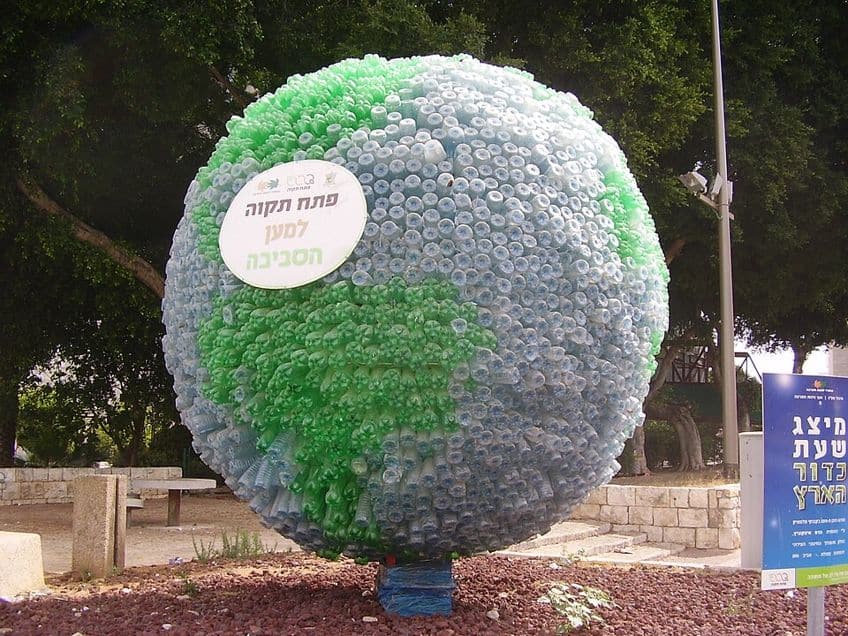
Engaging Viewers in a Dialogue
Recycled art engages viewers in a dialogue about the nature of beauty and its connection to our values and actions. Challenging conventional ideals, it encourages individuals to question their own aesthetic preferences and biases. Through exhibitions, installations, and public engagements, recycled art invites viewers to reflect on their own relationship with beauty, consumption, and sustainability.
As a result, fostering a greater appreciation for the innovative and transformative potential of recycled materials.
Exploring a Significant Found Object Artwork
In the realm of art, creativity knows no bounds, and artists have continuously sought innovative ways to push the boundaries of their craft. The roots of art made from recycled materials can be traced back to pioneering artists who embraced this concept long before it gained mainstream recognition. This section delves into the history of such an artwork, exploring the work of a visionary artist who was at the forefront of repurposing discarded materials to create remarkable artworks.
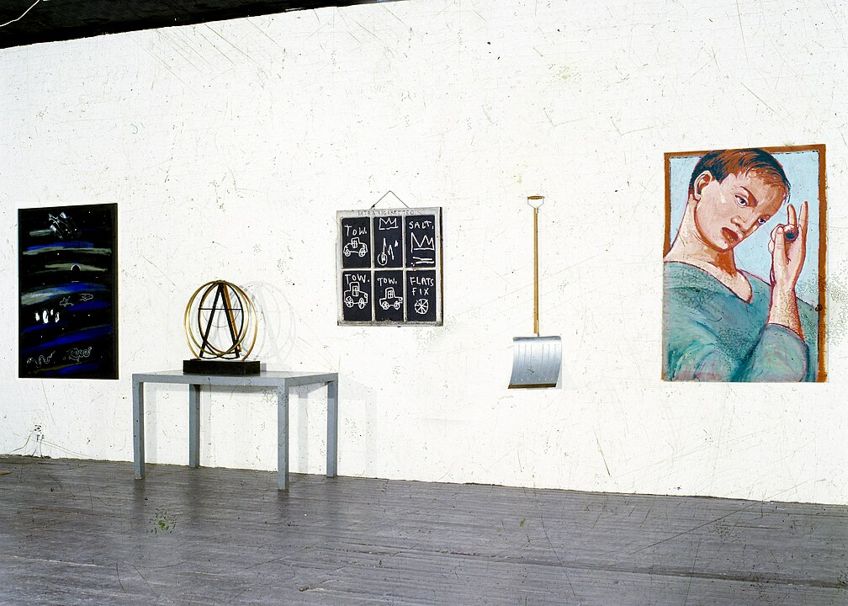
Garbage Art: Fountain (1917)
| Title | Fountain |
| Date | 1917 |
| Medium | Urinal |
| Dimensions (cm) | 61 x 36 x 48 |
| Style | Dada |
| Genre | Site-specific art |
| Location | San Francisco Museum of Modern Art, San Francisco, United States |
Fountain by Marcel Duchamp, created in 1917, is a seminal work of art that challenges traditional notions of artistic creation and the definition of art itself. It consists of a standard urinal, which Duchamp signed with the pseudonym “R. Mutt” and submitted for an exhibition organized by the Society of Independent Artists. Even though this artwork is technically not a recycled artwork (as Duchamp allegedly bought the urinal), it is significant to this topic as Fountain as well as all the other artworks in this artist’s Readymades series influenced the inclusion of recycled art into high art. Visually, Fountain raises questions about the relationship between ordinary objects and artistic significance. Duchamp’s decision to present a mass-produced urinal as a work of art subverts expectations and confronts the viewer with a familiar object placed in an unconventional context.
The urinal, detached from its usual function and presented as an artwork, challenges the notion of aesthetics tied to craftsmanship or visual beauty.
Conceptually, Fountain questions the authority of the artist and challenges the conventional ideas of originality and artistic skill. Duchamp’s act of choosing and presenting a manufactured object as art challenges the idea that artistic value is solely determined by the artist’s hand or creativity. Instead, he highlights the role of the artist as a conceptual thinker, capable of selecting and recontextualizing everyday objects to provoke new perspectives and discussions.
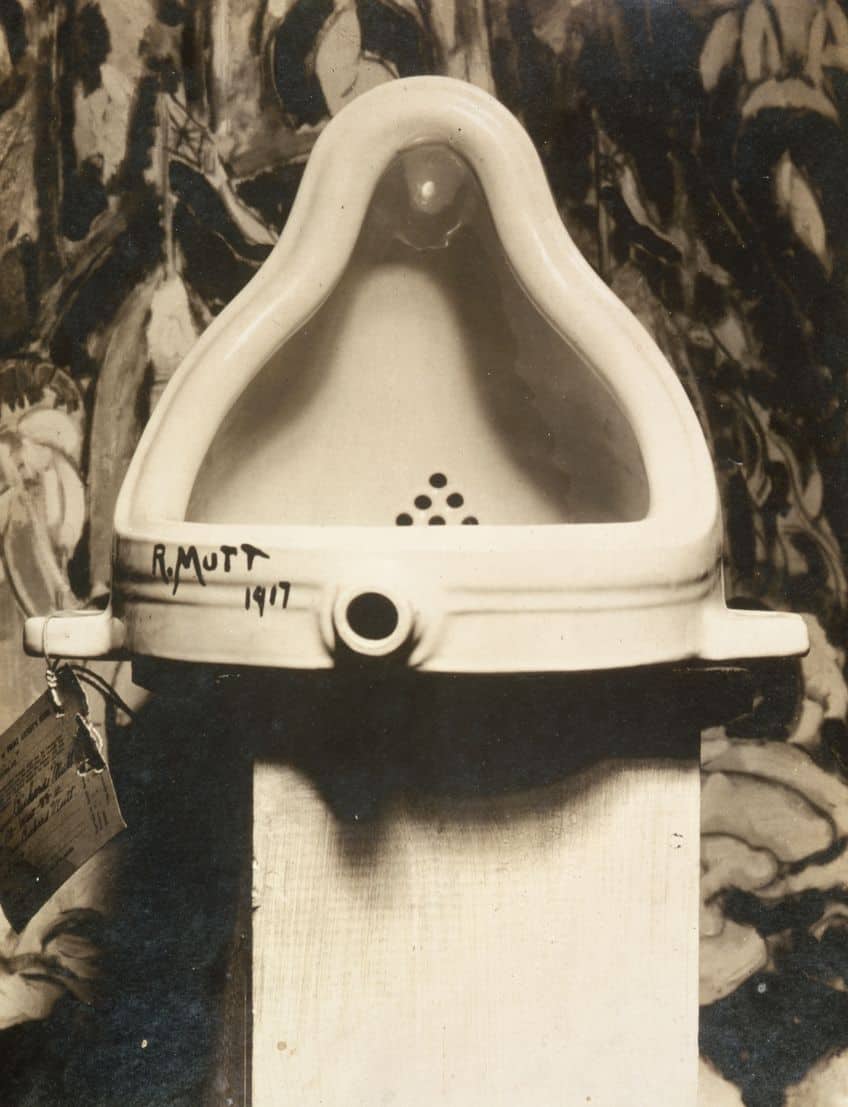
Furthermore, Fountain invites contemplation about the role of institutions and the art world in determining what is considered art. By submitting the urinal for exhibition, Duchamp challenged the authority and judgment of the art establishment, forcing them to confront their own preconceived notions of art and taste.
This act questioned the limits and boundaries of artistic expression and raised critical questions about the nature of art itself.
In essence, Fountain is a visual and conceptual disruption that challenges traditional ideas of art and raises fundamental questions about aesthetics, authorship, and the role of institutions in shaping artistic value. Duchamp’s provocative act with this readymade artwork paved the way for conceptual art and has had a profound and enduring impact on the course of art history, questioning our assumptions and expanding our understanding of what can be considered art.
Exploring the Works of Famous Recycled Art Artists: Transforming Waste into Artistic Masterpieces
Recycled art has witnessed the emergence of visionary artists who have redefined the boundaries of creativity by transforming discarded materials into captivating artworks. This section of the article delves into the careers of three influential recycled art artists and examines one notable artwork from each, providing insights into their artistic journeys and offering a brief visual and conceptual analysis of their creations. Through these artists’ innovative use of recycled materials, these three renowned artists have made significant contributions to the field of recycled art.
Each artist’s career context, coupled with the visual and conceptual analysis of their notable artworks, demonstrates the profound impact of recycled art in sparking conversations, promoting sustainability, and reshaping our understanding of art’s potential to address pressing social and environmental issues.
A Recycled Sculpture Art Piece by El Anatsui
| Title | Gravity and Grace |
| Date | 2010 |
| Medium | Multimedia: printing plates, recycled tins, and aluminum liquor bottle caps |
| Dimensions (cm) | 370 x 1120 |
| Style | Junk art |
| Genre | Installation |
| Location | Akron Art Museum, Akron, United States |
El Anatsui (1944-Present), a Ghanaian sculptor, is renowned for his monumental tapestries made from recycled materials, particularly discarded aluminum bottle caps and other metal fragments. An exemplary artwork by El Anatsui is Gravity and Grace (2009). This shimmering and visually stunning installation consists of intricately woven metal pieces, which he meticulously arranged into a tapestry-like composition.
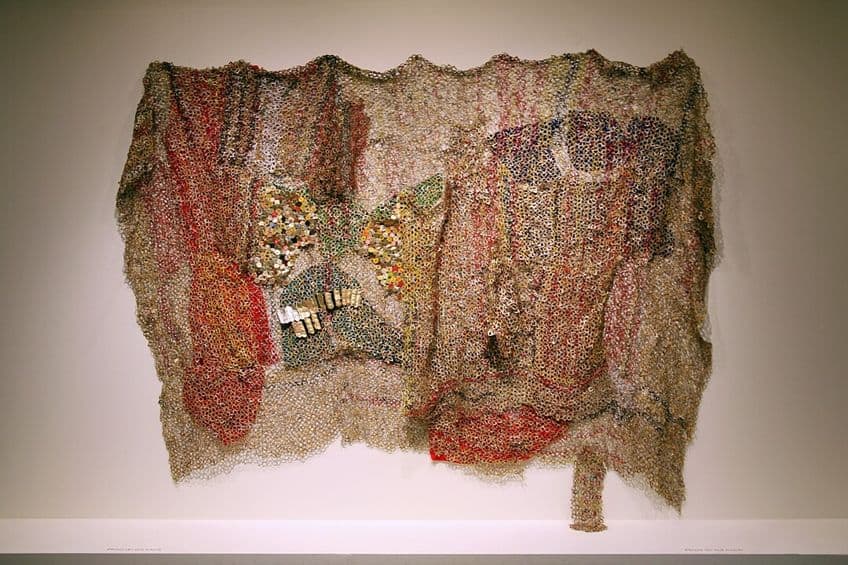
The artwork’s visual analysis reveals an interplay of colors, textures, and light, evoking a sense of fluidity and movement. The conceptual significance lies in Anatsui’s exploration of themes such as globalization, consumerism, and the reuse of materials. Gravity and Grace invites viewers to contemplate the transformative power of art and the interconnectedness of diverse cultures and histories.
Garbage Art by Vik Muniz
| Title | Pictures of Garbage: VW Beetle |
| Date | 2009 |
| Medium | Multimedia installation and photography |
| Dimensions (cm) | 180.34 x 207.01 |
| Style | Junk art |
| Genre | Photography |
| Location | Lima Museum of Contemporary Art, Lima, Peru |
Brazilian artist Vik Muniz (1961-Present) has gained international acclaim for his use of unconventional materials in his intricate and meticulously crafted artworks. One notable artwork by Muniz is Pictures of Garbage: VW Beetle (2009), from his Pictures of Junk series. Pictures of Garbage: VW Beetle (2009) by Vik Muniz is a captivating artwork that exemplifies Muniz’s meticulous attention to detail and his ability to transform unconventional materials into thought-provoking imagery. In this piece, Muniz recreates a classic Volkswagen Beetle using materials sourced entirely from a landfill, including discarded plastic, paper, and metal fragments.
Visually, Pictures of Garbage: VW Beetle astounds with its intricacy and craftsmanship. Muniz carefully arranges the garbage materials, meticulously composing each fragment to replicate the iconic shape and contours of the Beetle. The texture and color variations of the garbage materials add a dynamic quality to the artwork, revealing the diverse range of waste that constitutes our contemporary consumer culture.
The composition is visually striking, capturing the essence of the Beetle while simultaneously confronting viewers with the reality of waste and consumption.
Conceptually, Muniz’s work challenges our notions of value, beauty, and material worth. By elevating discarded and overlooked materials to the status of fine art, Muniz invites us to question our perception of what is considered valuable or disposable in our society. Through this transformative process, he prompts reflection on our consumerist tendencies and the consequences of our throwaway culture.
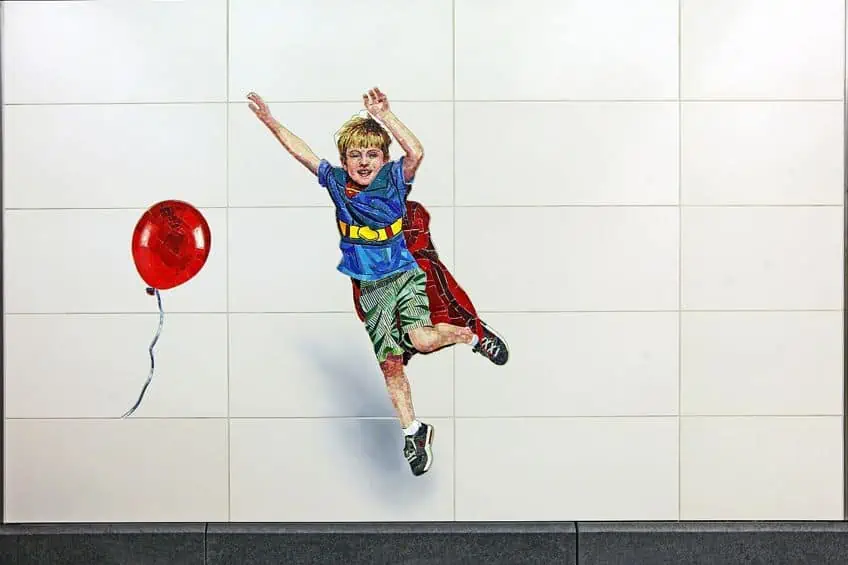 Perfect Strangers (n.d) by Vik Muniz; Metropolitan Transportation Authority of the State of New York, CC BY 2.0, via Wikimedia Commons
Perfect Strangers (n.d) by Vik Muniz; Metropolitan Transportation Authority of the State of New York, CC BY 2.0, via Wikimedia Commons
Moreover, Pictures of Garbage: VW Beetle serves as a poignant commentary on the environmental impact of consumerism and waste. By using landfill-sourced materials to recreate an emblematic symbol of consumer culture, Muniz confronts us with the consequences of our choices and highlights the urgent need for more sustainable practices.
The artwork invites viewers to contemplate the environmental cost of our consumption patterns and the potential for transformation and creative repurposing as solutions to our waste crisis.
In essence, Pictures of Garbage: VW Beetle combines visual allure with profound conceptual depth. Muniz’s ability to recreate an iconic car using discarded materials challenges our preconceived notions of beauty and value, while simultaneously drawing attention to the environmental implications of our consumer-driven society. The artwork provokes reflection, encouraging viewers to reconsider their relationship with material objects and the urgent need for sustainable alternatives.
A Trash Sculpture by Michelle Reader
| Title | Great Wave |
| Date | 2022 |
| Medium | Waste plastics |
| Dimensions (cm) | 100 x 240 x 60 |
| Style | Junk art |
| Genre | Sculpture |
| Location | National Space Centre, Leicester, United Kingdom |
Michelle Reader (1975-Present), a British artist, is known for her sculptural installations created from recycled materials found in urban environments. One striking artwork by Reader is Great Wave (2022), a large-scale installation comprising discarded plastic bottle caps and other plastic waste. The visual analysis of this artwork showcases a vibrant mosaic of colors and textures, reflecting the vast array of plastic objects that make up our daily lives.
Conceptually, Reader’s work draws attention to the issue of plastic pollution and its impact on the environment. Great Wave serves as a reminder of our collective responsibility to address the environmental crisis and encourages viewers to rethink their relationship with plastic consumption and waste.
In conclusion, recycled art has emerged as a powerful medium of creative expression, showcasing the ingenuity and resourcefulness of artists who transform discarded materials into captivating artworks. Through recycled art projects and the creation of art made from recycled materials, artists have redefined the boundaries of traditional art forms, breathing new life into materials that would otherwise be considered waste. Recycled sculpture art, also known as trash sculpture or garbage art, challenges our perception of beauty and provokes us to reconsider our relationship with consumer culture and the environment. By transforming trash into art, these artists invite us to reflect on sustainability, waste reduction, and the potential for artistic creation to inspire positive change. The remarkable artworks made from trash serve as a powerful reminder of the creative possibilities that lie within our discarded objects, urging us to see the world around us in a new light and inspiring us to embrace a more sustainable future.
Frequently Asked Questions
What Is Recycled Art?
Recycled art, also known as upcycled art or eco-art, refers to the creation of artistic pieces using materials that have been repurposed or recycled from their original form. Instead of traditional art supplies, recycled art utilizes discarded objects such as scrap metal, plastic bottles, newspapers, and other items that would otherwise be thrown away as waste. Artists transform these materials into unique artworks, demonstrating creativity, resourcefulness, and a commitment to environmental sustainability. Recycled art not only reduces waste, but also raises awareness about the importance of recycling and repurposing materials in our daily lives.
What Is the Purpose of Art Made from Recycled Materials?
Recycled art transcends its aesthetic appeal and assumes the role of a catalyst for environmental awareness and change. Through repurposing discarded materials, artists invite us to reflect on our consumer-driven society and reconsider our relationship with waste. By inspiring sustainable practices, fostering education, and engaging communities, recycled art promotes environmental consciousness and empowers individuals to become active participants in creating a greener, more sustainable world. As we appreciate the beauty and significance of recycled art, we are reminded that art has the power to inspire transformation, ignite dialogue, and ultimately shape a more harmonious relationship between humans and the environment.
How Does Recycled Art Promote Relational Thinking?
Recycled art exemplifies the inherent relationality between people, materials, and the environment. Through creative repurposing and the transformation of discarded materials, artists forge meaningful connections that challenge conventional boundaries and inspire a sense of collective responsibility. Recycled art encourages us to rethink our relationships with materials, waste, and the natural world, fostering empathy, awareness, and a commitment to sustainability and environmental stewardship. By recognizing the interconnectedness between our choices, actions, and the well-being of our planet, recycled art invites us to embrace a more harmonious relationship with the world around us. Through its ability to engage viewers, foster community collaboration, and inspire transformative change, recycled art serves as a powerful testament to the potential for art to shape a more sustainable and interconnected future. It reminds us that our actions matter and that by reimagining our relationships with materials, waste, and the environment, we can create a more vibrant and harmonious world for present and future generations.
Is Recycled Art Beautiful?
Recycled art boldly challenges and engages the ideals of beauty, offering a fresh perspective that embraces imperfection, transformation, and sustainability. By repurposing discarded materials and creating visually captivating artworks, recycled artists redefine our understanding of aesthetics and invite us to reconsider the value we assign to objects and materials. Through this process, recycled art not only challenges societal norms, but also inspires us to cultivate a more inclusive, meaningful, and sustainable vision of beauty in our everyday lives.
Nicolene Burger, a South African multimedia artist and creative consultant, specializes in oil painting and performance art. She earned her BA in Visual Arts from Stellenbosch University in 2017. Nicolene’s artistic journey includes exhibitions in South Korea, participation in the 2019 ICA Live Art Workshop, and solo exhibitions. She is currently pursuing a practice-based master’s degree in theater and performance. Nicolene focuses on fostering sustainable creative practices and offers coaching sessions for fellow artists, emphasizing the profound communicative power of art for healing and connection. Nicolene writes blog posts on art history for artfilemagazine with a focus on famous artists and contemporary art.
Learn more about Nicolene Burger and about us.
Cite this Article
Nicolene, Burger, “Recycled Art – Environmental Art Made from Trash.” artfilemagazine – Your Online Art Source. July 5, 2023. URL: https://artfilemagazine.com/recycled-art/
Burger, N. (2023, 5 July). Recycled Art – Environmental Art Made from Trash. artfilemagazine – Your Online Art Source. https://artfilemagazine.com/recycled-art/
Burger, Nicolene. “Recycled Art – Environmental Art Made from Trash.” artfilemagazine – Your Online Art Source, July 5, 2023. https://artfilemagazine.com/recycled-art/.


